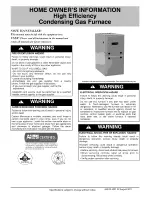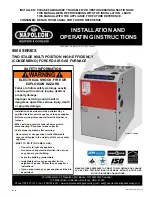
7
Installations must adhere to the clearances to combustible
materials to which this furnace has been design certified.
The minimum clearance information for this furnace is
provided on the unit’s clearance label. These clearances
must be permanently maintained. Clearances must also
accommodate an installation’s gas, electrical, and drain
trap and drain line connections. If the alternate combustion
air intake or vent/flue connections are used additional
clearance must be provided to accommodate these
connections. Refer to
Vent/Flue Pipe and Combustion Air
Pipe
for details.
NOTE: In addition to the required clearances to
combustible materials, a minimum of 24 inches
service clearance must be available in front of
the unit.
POSITION*
SIDES
REAR
FRONT BOTTOM
FLUE
TOP
Upflow
0"
0"
3"
C
0"
1"
Horizontal
6"
0"
3"
C
0"
6"
C = If placed on combustible floor, floor MUST be wood only.
*MEC96 MINIMUM CLEARANCES TO COMBUSTIBLE MATERIALS
(INCHES)
POSITION*
SIDES
REAR
FRONT BOTTOM FLUE
TOP
Counterflow
0"
0"
3"
NC
0"
1"
Horizontal
6"
0"
3"
C
0"
6"
C = If placed on combustible floor, floor MUST be wood only.
NC = For installation on non-combustible floors only. A combustible subbase
must be used for installations on combustible flooring.
*CEC96 MINIMUM CLEARANCES TO COMBUSTIBLE MATERIALS
(INCHES)
TOP
BOTTOM
TOP
BOTTOM
Figure 1
A furnace installed in a confined space (i.e., a closet or
utility room) must have two ventilation openings with a
total minimum free area of 0.25 square inches per 1,000
BTU/hr of furnace input rating. Refer to Specification
Sheet applicable to your model for minimum clearances to
combustible surfaces. One of the ventilation openings must
be within 12 inches of the top; the other opening must be
within 12 inches of the bottom of the confined space. In a
typical construction, the clearance between the door and
door frame is usually adequate to satisfy this ventilation
requirement.
WARNING
CARBON MONOXIDE POISONING HAZARD
Failure to follow the steps outlined below for each
appliance connected to the venting system being placed into
operation could result in carbon monoxide poisoning or
death.
The following steps shall be followed with each appliance
connected to the venting system placed in operation, while
any other appliances connected to the venting system are
not in operation:
1. Seal any unused openings in the venting system.
2. Inspect the venting system for proper size and
horizontal pitch, as required by the National Fuel
Gas Code, ANSI Z223.1 or the Natural Gas and Propane
Installation Code, CSA B149.1-15 and these instructions.
Determine that there is no blockage or restriction,
leakage, corrosion and other deficiencies which could
cause an unsafe condition.
3. As far as practical, close all building doors and
windows and all doors between the space in which
the appliance(s) connected to the venting system are
located and other spaces of the building.
4. Close fireplace dampers.
5. Turn on clothes dryers and any appliance not
connected to the venting system. Turn on any exhaust
fans, such as range hoods and bathroom exhausts, so
they shall operate at maximum speed.
Do not operate a summer exhaust fan.
6. Follow the lighting instructions. Place the appliance
being inspected in operation. Adjust thermostat so
appliance shall operate continuously.
7. Test for spillage from draft hood appliances at the
draft hood relief opening after 5 minutes of main
burner operation. Use the flame of a match or candle.
8. If improper venting is observed during any of the
above tests, the venting system must be corrected
in accordance with the National Fuel Gas Code ANSI
Z223.1/NFPA 54 and/or National Gas and Propane
Installation Code CSA B149.1-15.
9. After it has been determined that each appliance
connected to the venting system properly vents when
tested as outlined above, return doors, windows,
exhaust fans, fireplace dampers and any other gas
burning appliance to their previous conditions of use.








































